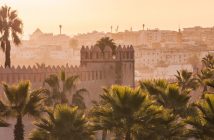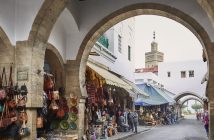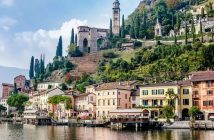I’m in the bowels of a rickety old vessel that sounds like it’s on its last legs. The noise of the engine as we slice through the Tyrrhenian Sea is deafening. Sat below deck, the July heat is furnace-like. Elderly women fan themselves frantically. The men seem unphased and continue to read their papers, their sweaty fingers smudging the ink on the page.
Staring out of the window at the sea swelling past me, I wonder if the ship will make it to the island I’m bound for – Salina, the second largest of the Aeolian Islands after Lipari. My journey thus far has been eventful. Stepping out of Catania airport into the searing mid-morning heat, I was hurried into a taxi and driven by a suave young Sicilian at breakneck speed to the port. The ferry schedule is erratic and a missed boat can mean hours of waiting for the next one.
After stops at the neighbouring islands of Vulcano and Stromboli, we finally moor up in Salina – a sense of relief sweeps over me, which, mingled with the heat, makes me drowsy and desirous of sleep. Home to just 4,000 souls, Salina’s rugged beauty reveals itself during the short taxi ride to my hideaway for the next two nights – Capofaro. A former Greek settlement once known as Didyme, Salina boasts six volcanoes and is a World Heritage site, making property development virtually impossible and preservation of the land paramount.

Mercifully, all six of the volcanoes are inactive – they haven’t had an eruption here for 13,000 years, but the land bears the scars of its volcanic past and its wines benefit from the mineral-rich volcanic soils the grapes are grown on. Home to over 400 different types of flora and fauna including poplars, prickly pears and chestnut trees, it’s capers the island is best known for – Salina is said to boast the best in the world. Fat and salty, they are hand harvested in the early hours of the morning before the sun begins its ascent.
With its mountainous terrain, copious caper bushes and bursts of bougainvillea, Salina bears a striking resemblance to Pantelleria, the satellite island southwest of Sicily where A Bigger Splash was filmed. Arriving at Capofaro, my luggage scoots off in a golf buggy and I’m handed a cold towel scented with rose water and a chilled glass of water with a squeeze of local lemon juice. Both offer welcome refreshment after the arduous journey.
A boutique resort named after the lighthouse within its grounds, Capofaro is formed of 18 apartments dotted among manicured rows of Malvasia vines that stretch like corridors down to the ocean. The resort is owned by the Tasca family, who have been making wine in Sicily for eight generations. Run by brothers Giuseppe and Alberto, the Tasca family business takes in five wine estates including three in Sicily and one on the tiny island of Mozia. A well respected name in Sicilian wine, the family produces everything from Grillo, Grecanico and Grappa to Nero d’Avola and Nerello Mascalese.

Capofaro boasts thousands of vines planted across 12 acres of land at the foot of a perilously steep mountain. From them come a pair of Malvasias, one dry and one sweet, both boasting the grape’s hallmark aromas of jasmine, honeysuckle, rose water and white peach. Malvasia is so revered on the island it has its own day in early July when local producers flock to a chosen spot to show off their wares to residents and tourists alike. This year’s festival was held at Capofaro.
After unpacking I enjoy a dip in the pool then unwind on the terrace of my apartment, whose pristine white walls pop against the cobalt blue sky, reminding me of the whitewashed town of Mijas in Andalusia. Enjoying a flute of Almerita Rosé, an elegant sparkling Pinot Noir made at one of the Tasca family’s Sicilian estates – Tenuta Regaleali – I drink in my surroundings. The bees are as loud as lawnmowers and a querulous cockerel seems to think it’s already morning. Cicadas trill in the silvery olive trees and the ocean is as still as a painting, punctuated by a solitary sailboat. In the distance are the islands of Panarea and Stromboli that look barely bigger than a pair of rocks and dissolve as the sun sets, turning the sky from mauve to black.
Before dinner I’m introduced to Capofaro’s handsome head chef, Ludovico de Vivo. Having notched up stints at René Redzepi’s Noma in Copenhagen and Heston Blumenthal’s The Fat Duck in Bray, de Vivo has learnt from the best and his dishes tip their hat to Heston’s playfulness and René’s passion for local produce. All of the ingredients used in his dishes are sourced from the island and his menu is weighted heavily towards fish, giving the limelight to the likes of swordfish and tuna. Taking a leaf out of Redzepi’s book, de Vivo grows the majority of his vegetables and makes his own bread, butter and pasta.

His dishes are painterly in presentation and flecked with edible flowers. Sitting down to dinner in Capofaro’s whitewashed, doorless dining room with a bamboo roof and a flurry of fans twisting lazily overhead, among the culinary highlights is a curious dish composed of semolina sheets, a strip of crispy bacon and raw red prawns drizzled in egg yolk, which sounds like a deconstructed Sunday brunch but tasted divine. Also on point is a hunk of feather-light swordfish topped with crushed almonds and pistachios, which de Vivo enlivens with potent drops of lemon zest. His milk ice cream meanwhile is hugely nostalgic, taking me back to treasured trips to the ice cream van for a vanilla Mini Milk.
While the voyage to Salina is not for the faint-hearted, Capofaro merits the pilgrimage. Be sure to stay for a minimum of a long weekend to give you time to fully relax and unwind before the long journey home. Life is slow here, making it the perfect place for a digital detox. As the Italians say, there is sweetness in doing nothing.
For more information on Capofaro, visit www.capofaro.it.




